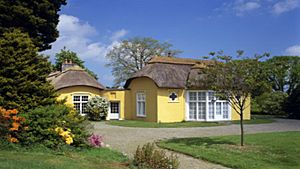Derrymore House facts for kids
Derrymore House (called Teach Dhoire Mhóir in Irish) is a beautiful old house in Bessbrook, County Armagh, Northern Ireland. It is looked after by the National Trust, an organization that protects important places. The large gardens around the house are open to visitors for most of the year. A special room inside the house, known as the "Treaty Room," is open on certain days. The National Trust describes Derrymore House as a unique 18th-century house with a traditional thatched roof.
Contents
What Makes Derrymore House Special?
A Unique Thatched House
Derrymore House is a single-story building designed like a "cottage orné" (a fancy cottage). It sits within a large, partly-walled estate that covers about 100 acres (0.4 square kilometers) of parkland and woods. One of its most special features is its roof, which is thatched using unique reeds from the River Shannon.
The Beautiful Parkland
The lovely parkland around Derrymore House was designed by John Sutherland. He was a famous landscape designer who learned from the well-known Capability Brown. The park includes areas of trees, a large walled garden that isn't used much anymore, and a small quarry. There's also a short walking trail for visitors to enjoy.
Gate Lodges and Buildings
Within the grounds, there are four smaller buildings called gate lodges. One of these was the home of the head gardener, known as Hortus Lodge. These lodges were added to the estate at different times in the 1800s.
The History of Derrymore House
Isaac Corry: The First Owner
Derrymore House was built between 1776 and 1787. It was built by a man named Isaac Corry. He was a Member of Parliament (MP) for Newry for 30 years. He inherited the land from his father. People at the time described the house as a very elegant summer home.
Isaac Corry was the last person to hold the job of Chancellor of the Exchequer of Ireland. This was an important role in the government before Ireland joined with Great Britain in 1800. This event was called the Act of Union 1800. Some people believe that the Act of Union might have been discussed in the drawing room of Derrymore House. This room is now often called the "Treaty Room." However, the actual signing of the Act happened in Dublin.
Later Owners and Changes
Isaac Corry sold Derrymore House in 1810 when he moved to Dublin. Later, the Young family bought it. In 1825, Sir William Young sold the estate to the Smyth family. The estate, which had many trees, was then bought by a rich merchant named Robert Glenny.
Robert Glenny later sold it to John Grubb Richardson, a linen manufacturer. Richardson lived in the neighboring estate. He was important because he helped create the village of Bessbrook. He also built the Bessbrook Friends' Meeting House, which is located within the Derrymore estate.
Donated to the National Trust
In 1952, Mr. J. S. W. Richardson, a descendant of John Grubb Richardson, gave Derrymore House and its estate to the National Trust. The National Trust then decided to remove a large part of the house that the Richardson family had added. They did this to make the house look more like it did when Isaac Corry first owned it.
Challenges and Restoration
During a period known as The Troubles (between 1972 and 1979), Derrymore House was damaged several times. The person looking after the house at the time, Edmund Baillie, bravely moved some dangerous devices away from the house into the garden. Because of this damage, most of the wooden parts of the house had to be replaced, and some changes were made inside.
World War II Camp
During World War II, the Derrymore estate was used as a military camp. Most of the buildings from that time have since been removed, and the land has been restored. However, you can still see a concrete road and some earthworks from that period. The US Army used the estate as a supply depot from November 1943 to August 1944.
Derrymore House Today
Managing the Property
In recent years, a company has helped the National Trust manage Derrymore House. Different people have lived in the two wings of the house. The National Trust still uses the main central area, especially the drawing room, for various events. There are plans to update the wings so that different people can live there without affecting the National Trust's activities.
Future Plans for the Estate
In 2019, money was secured to improve the Derrymore Estate even more. These plans include creating new walking trails with different themes. There will also be new play areas, places to sit, and viewing spots. These improvements will make the estate even more enjoyable for visitors.
External links
- Derrymore House – The National Trust


